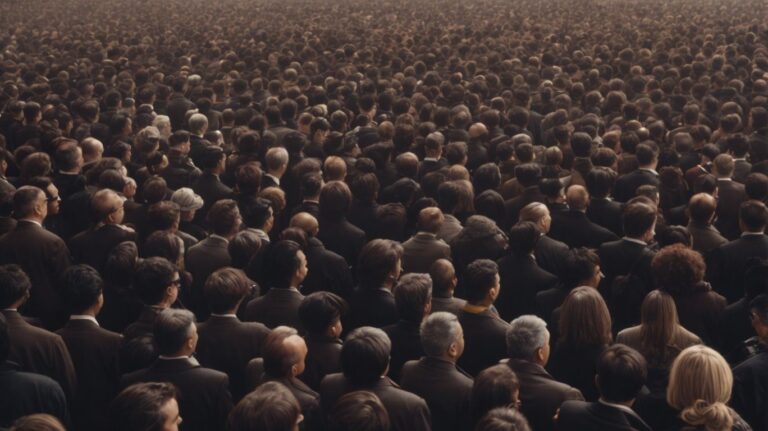Social facilitation is a fascinating phenomenon that examines how the presence of others can impact an individual’s performance. In this article, we will explore the theories behind social facilitation, how it works, the factors that influence it, and the various types of social facilitation.
We will also discuss the effects of social facilitation, differentiate it from social inhibition, and provide real-life examples to help you better grasp this concept. So, let’s dive into the world of social facilitation in AP Psychology!
Contents
- 1 What Is Social Facilitation?
- 2 How Does Social Facilitation Work?
- 3 What Are The Types Of Social Facilitation?
- 4 What Are The Effects Of Social Facilitation?
- 5 How Is Social Facilitation Different From Social Inhibition?
- 6 What Are Some Real-life Examples Of Social Facilitation?
- 7 Frequently Asked Questions
- 7.1 What is social facilitation in AP Psychology?
- 7.2 What are the two types of social facilitation?
- 7.3 How does social facilitation affect performance?
- 7.4 Can social facilitation be explained by the Yerkes-Dodson Law?
- 7.5 How does social facilitation differ from social loafing?
- 7.6 What are some real-life examples of social facilitation?
What Is Social Facilitation?
Social facilitation is a psychological phenomenon where individuals tend to perform better on tasks in the presence of others compared to when alone.
This phenomenon can be explained through the activation theory, which suggests that the mere presence of others can create arousal, leading to an increased likelihood of performing dominant responses in a given task. In situations where the task is simple or well-rehearsed, such as riding a bike or typing, the presence of others tends to enhance performance. For more complex tasks that require deeper cognitive processing, social facilitation may not always lead to improved outcomes.
What Are The Theories Behind Social Facilitation?
The theories behind social facilitation encompass a range of psychological concepts such as the audience effect, co-action effect, activation theory, and the impact of arousal levels on performance.
Looking closer at the audience effect, it explains how the mere presence of others can impact an individual’s performance, often leading to enhanced performance on well-practiced or simple tasks but potentially hindering performance on complex or novel tasks. The co-action effect, on the other hand, delves into how the simultaneous presence of others engaging in the same task can boost motivation and effort. Activation theory posits that the arousal elicited in group settings can enhance an individual’s dominant response, leading to improved performance in well-learned tasks.
How Does Social Facilitation Work?
Social facilitation operates through mechanisms such as the activation theory, where the arousal level in a group setting enhances individual performance through heightened motivation and engagement.
Activation theory suggests that the mere presence of others can influence an individual’s arousal level, thereby affecting their behavior. When surrounded by a group, individuals often experience an increase in alertness and energy, which can lead to improved performance on simple or well-rehearsed tasks.
On the contrary, for complex or unfamiliar tasks, this heightened arousal can trigger evaluation anxiety, causing individuals to feel pressured by the presence of others. This evaluation anxiety can lead to a decline in performance as the individual becomes overly self-conscious and focuses more on avoidance of embarrassment rather than the task at hand.
What Are The Factors That Influence Social Facilitation?
Several factors have a significant impact on social facilitation, including evaluation anxiety, the presence of an audience or spectators, peer pressure, and inherent group biases.
In terms of evaluation anxiety, individuals may feel increased pressure to perform well when being observed by others, leading to either an enhancement or inhibition of their performance based on their comfort level with the task at hand. This phenomenon is closely related to the concept of the Yerkes-Dodson law, which suggests that there is an optimal level of arousal for performance.
The presence of an audience can create a sense of accountability and drive individuals to perform better, known as the ‘audience effect.’ This effect can be seen in various settings, such as athletes performing better in front of a crowd or students delivering speeches in front of their peers.
Peer pressure, another key factor, can either positively or negatively influence behavior depending on the dynamics of the group. For instance, a competitive environment may push individuals to excel, while a group with low motivation levels can hinder performance.
Inherent group biases, such as favoritism or conformity pressures, play a role in shaping social facilitation outcomes. Groups tend to exhibit ingroup biases, favoring members of their own group, which can impact individual performance and interaction within the group.
What Are The Types Of Social Facilitation?
Social facilitation manifests in various types, including the co-action effect, audience effect, and the differential impact on performance across simple and complex tasks.
In the context of the co-action effect, individuals tend to perform better when working alongside others, often experiencing a boost in motivation and energy levels due to the presence of peers. On the other hand, the audience effect highlights how the performance of an individual may be influenced by the presence of spectators, leading to heightened arousal levels and sometimes improved performance, especially in well-learned tasks.
When examining the differential impact of social facilitation on simple versus complex tasks, it becomes evident that individuals may excel in familiar tasks under social observation, while complex tasks might suffer due to increased pressure and cognitive overload.
Co-action Effect
The co-action effect in social facilitation highlights how the presence of others can increase an individual’s arousal level, leading to improved performance and potentially contributing to group conflicts or enhancing collective benefits.
When individuals are engaged in a task alongside others, their drive to perform well is often heightened, primarily due to the psychological impact of shared presence and the innate desire to demonstrate competence in a social context. This phenomenon, known as the co-action effect, has been extensively studied in the domains of psychology and sociology to understand the intricate interplay between individual behavior and group dynamics.
The concept ties closely with the bystander effect, where the diffusion of responsibility among group members can either hinder or facilitate intervention in a conflict situation, impacting the overall group outcomes.
Audience Effect
The audience effect explores how individuals may experience heightened performance or evaluation anxiety when performing tasks in front of an audience, influenced by factors like peer pressure and the fear of judgment.
It is fascinating how the mere presence of others can either enhance or hinder an individual’s performance. This phenomenon taps into the intricate interplay between social dynamics and personal behavior.
The concept of social facilitation delves into how the presence of an audience can boost motivation and focus, resulting in improved performance in simple or well-rehearsed tasks. Complex or new tasks may elicit the opposite effect, known as social inhibition. This dichotomy unveils the nuanced nature of human behavior in social contexts.
Drive Theory
Drive theory in social facilitation posits that an individual’s motivation and arousal level can be influenced by the presence of others, leading to enhanced performance on tasks.
This phenomenon is underscored by the concept of social facilitation, where individuals tend to perform better in the presence of others. The mere presence of a group can trigger an innate competitive drive, causing an individual to strive for excellence to stand out amongst their peers.
The synergy of group dynamics can create a positive feedback loop, where each person’s effort contributes to the collective motivation, propelling everyone towards better performance. This dynamic interplay of mutual influence and cohesiveness within a group can significantly impact individual behavior and productivity.
Evaluation Apprehension
Evaluation apprehension focuses on the anxiety individuals feel when being evaluated or monitored by others, impacting their performance and self-awareness within group settings.
In social facilitation, the presence of an audience can significantly influence behavior. This phenomenon was highlighted by Robert Zajonc’s theory, suggesting that individuals perform tasks better when in the presence of others, but only when the task is simple or well-practiced. This phenomenon can be seen in everyday situations, such as giving a speech in front of a large audience or playing a musical instrument in a concert hall.
Distraction Conflict Theory
The distraction conflict theory posits that the presence of others may create a cognitive conflict, leading to increased arousal levels that can impact individual performance and psychological processes.
When individuals are in a group setting, their attention is divided between the task at hand and the presence of others, causing a conflict in cognitive processing. This conflict can trigger a heightened state of arousal as the individual navigates between focusing on the task and external social influences.
This increased arousal can lead to either improved performance, as seen in social facilitation, or diminished results if the cognitive load becomes overwhelming.
Yerkes-Dodson’s Law further supports this notion by suggesting that optimal performance is achieved at moderate levels of arousal, highlighting the delicate balance required in social contexts.
What Are The Effects Of Social Facilitation?
The effects of social facilitation can manifest in both positive and negative outcomes, influencing individual performance and behavior in diverse settings.
Social facilitation, originating from the presence of others, often leads to improved performance on simple or well-rehearsed tasks due to heightened arousal and motivation.
For example, one may find an athlete performing better in a competition with a supportive crowd cheering them on, showcasing the positive impact of social facilitation.
Conversely, in more complex or novel tasks, individuals might experience performance anxiety or pressure, resulting in a decline in their capabilities.
Group biases and self-interest can further influence these effects, shaping how individuals perceive and respond to social facilitation.
Positive Effects
Positive effects of social facilitation include heightened motivation, improved performance, and the potential for achieving collective benefits through enhanced group dynamics and collaboration.
For instance, in a workplace setting, individuals may find themselves working more efficiently when surrounded by colleagues who are also diligently engaged in their tasks. This shared focus can create a positive atmosphere that spurs each team member to strive for excellence, ultimately leading to increased productivity and output.
Social facilitation can be observed in sports events where athletes perform better in front of cheering crowds. The energy and encouragement from the spectators serve as a driving force, propelling the athletes to push their limits and deliver exceptional performances, showcasing the power of social influence on individual achievement.
Negative Effects
Negative effects of social facilitation may include increased evaluation anxiety, heightened conflicts within groups, and challenges arising from individual self-interest conflicting with collective goals.
Social facilitation, in certain contexts, can intensify the pressure individuals feel when being evaluated, leading to heightened evaluation anxiety.
For example, in a workplace setting where team members are required to present their individual work in a group meeting, the fear of judgment from peers and supervisors can exacerbate this anxiety, hindering performance.
Within groups, social facilitation can sometimes create an environment ripe for conflict.
When different opinions and personalities confront each other in a group setting, the competitive nature of social facilitation can escalate tensions, leading to disagreements, power struggles, and ultimately impeding collaboration and productivity.
The clash between individual self-interest and group objectives, often fueled by social facilitation, can create a dynamic where personal achievements overshadow collective success.
For instance, in a sports team where players demonstrate their abilities to outshine others rather than working together for the team’s victory, the negative impact of social facilitation on teamwork becomes evident.
How Is Social Facilitation Different From Social Inhibition?
While social facilitation refers to improved performance in the presence of others, social inhibition involves a decline in individual performance under similar social conditions.
These two concepts have been extensively studied in psychology and have provided valuable insights into how the presence of others can influence human behavior. Social facilitation typically occurs with simple or well-rehearsed tasks where the individual is confident in their abilities, leading to enhanced performance. On the other hand, social inhibition is more likely to occur when individuals are faced with complex or unfamiliar tasks, causing a decline in performance due to heightened self-awareness and anxiety.
What Are Some Real-life Examples Of Social Facilitation?
Real-life instances of social facilitation can be observed in contexts such as sports events, concerts, and public speaking engagements where individuals may exhibit enhanced performance in the presence of a crowd.
Sports competitions provide a classic example of social facilitation, where athletes often perform better when competing in front of a large audience. For instance, a tennis player may deliver more powerful serves and precise shots when playing in a stadium filled with cheering fans compared to a practice session.
In music performances, musicians frequently experience the effects of social facilitation. A guitarist playing a solo in front of a live audience may feel a surge of adrenaline that boosts their focus and energy, leading to a more captivating and dynamic performance.
Similarly, public speakers often deliver more engaging speeches when addressing a crowded room. The pressure of being watched and evaluated by an audience can stimulate speakers to speak more confidently and persuasively than when practicing alone.
Sports Events
Sports events often demonstrate the audience effect within social facilitation, where athletes may experience heightened performance levels influenced by the spectators and the pressure to excel.
This phenomenon highlights the significant impact of the environment on an athlete’s mindset and behavior. When surrounded by cheering fans and supporters, individuals tend to push themselves beyond their limits, driven by the energy and motivation derived from the collective atmosphere.
This concept ties into the broader discussion of group dynamics and how being part of a team or community can enhance an athlete’s performance. The presence of peers can inspire a sense of responsibility and accountability, pushing athletes to strive for excellence not just for themselves but for their team as well.
Concerts
Concerts provide a platform for social facilitation to enhance the collective experience as individuals come together, amplifying their arousal levels and contributing to a sense of shared enjoyment.
Within a concert setting, the presence of a large group of enthusiastic individuals creates a social trap where each person’s behavior is influenced by the crowd dynamics, leading to an overall heightened emotional response. This shared emotional intensity not only fosters a deeper connection with the music and the performers but also strengthens the sense of community building among attendees, making the concert experience more enriching and memorable. The palpable energy in the air, the synchronized reactions, and the shared emotional journey all contribute to a unique social environment that transcends individual enjoyment.
Public Speaking
Public speaking engagements often trigger evaluation anxiety as individuals perform in front of an audience, showcasing the complexities of social facilitation in managing self-awareness and communication effectiveness.
One prime challenge faced by speakers is evaluation anxiety, a psychological phenomenon where individuals anticipate judgment and criticism from their audience, leading to increased nervousness and stress. This anxiety can hinder one’s ability to convey their message effectively, as they become focused on their perceived shortcomings rather than the content of their speech.
Additionally, self-awareness plays a crucial role in public speaking, as speakers must navigate their internal thoughts and feelings while simultaneously engaging with the audience. Maintaining a balance between self-reflection and audience interaction can be demanding, as excessive self-consciousness may impede a speaker’s natural delivery and connection with the listeners.
Frequently Asked Questions
Social facilitation in AP Psychology refers to the phenomenon where an individual’s performance is influenced by the presence of others. It can either improve or hinder their performance depending on the task and the social environment.
The two types of social facilitation are the co-action effect and the audience effect. The co-action effect occurs when an individual’s performance is enhanced by the presence of others working towards the same goal. The audience effect occurs when an individual’s performance is influenced by the presence of passive spectators.
Social facilitation can either enhance or hinder an individual’s performance. The presence of others can increase arousal and motivation, leading to improved performance on simple or well-practiced tasks. However, it can also create anxiety and distraction, resulting in decreased performance on complex or unfamiliar tasks.
Yes, social facilitation can be explained by the Yerkes-Dodson Law, which states that performance is optimal at a moderate level of arousal. The presence of others can increase arousal, but it may reach a point where it becomes too much and hinders performance, especially on complex tasks.
Social facilitation and social loafing are two opposing effects of the presence of others. While social facilitation refers to improved performance, social loafing refers to decreased effort and performance in a group setting. Social loafing occurs when individuals feel less personally responsible for the outcome of a group task.
Some real-life examples of social facilitation include athletes performing better in front of a cheering crowd, musicians giving a more energetic performance when playing in a group, and employees working more efficiently when their boss is present. It can also be seen in everyday situations, such as people driving more carefully when others are in the car with them.



